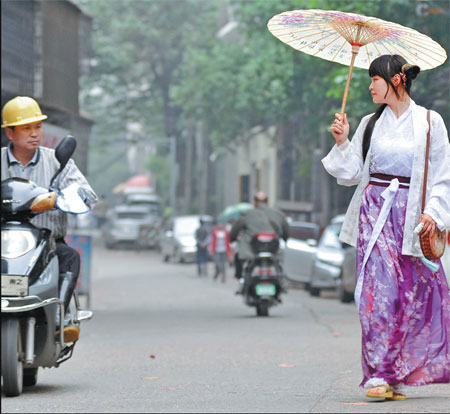About two years ago, Long Jiayan accidentally watched a video about hanfu, or Han clothing, on a micro blog in China. She didn't expect that it would inspire her life's passion to promote Han clothing and its history.
Hanfu is the traditional dress of the ethnic Han people. However, few Han people wear it daily in present-day China. It can be seen occasionally in festivals, coming-of-age and religious ceremonies conducted by Taoist, Confucian and Buddhist monks.
It is often seen, however, in Chinese television serials and movies.
"I absolutely fell in love with hanfu, including all of its connotations and cultural implications after watching the video," says the 24-year-old in Changsha, Hunan province.
Long was so crazy about hanfu that she, who never learned sewing before, started to make an outfit only four days after she watched the video.

"I searched for information about how to make hanfu and felt after my reading that it was not that difficult, so I just set to work on it," she recalls.
Long's baby was just 7 months old, so she could only make the clothes when the baby slept or when it was being cared by its grandmother.
But Long's idea didn't get any support from her family. "My mother-in-law said I had a 'mental disorder' and it was unnecessary and boring to do that," she says.
Long finished her first hanfu in only three days, even though she didn't have a sewing machine, and she wore it immediately.
"Honestly, I don't know how I managed to keep that mental state then. I was fully at ease, though I had expected that people would look at me strangely," Long says.
Now Long wears hanfu at least half the time. Sometimes she also chooses to wear some modern items to go with her hanfu.
"When I wear hanfu on the street, some people even ask if I'm doing cosplay or wearing a costume rented from a photographic studio," she says.
"But I was quite happy to hear that some children called me fairy sister," she says.
One month later after she made the first hanfu, she bought a sewing machine for 800 yuan ($129).
"I'm the type of person who takes action. I spent all of my pocket money on the sewing machine and the cloth," Long says.
Now Long has her workshop and has made several hundred hanfu, but learning how to stitch was not easy.
"What I can do is to turn to the pictures about hanfu and search for instructions some people post on the Internet. I bought some cheap cloth and tried to make hanfu with that," she says.
Long has so far concentrated on the clothing's cut and form. "I plan to do myself print, dye and embroider on the clothes that I make. But that requires more effort as traditionally pictures are used on hanfu and some pictures cannot be used on some types of fabric," she says.
In June last year, Long launched her online store. Many people have come to her workshop, tried her hanfu and taken pictures, but sales are low.
Long says she has been in debt of more than 10,000 yuan. Her suits mostly cost 300-400 yuan. "But many people still think they are expensive," Long says.
Sometimes, she says, she has to spend more than one month browsing hundreds of webpages and looking into thousands of cloth types to find what she wants.
Long isn't alone in her dream to rejuvenate traditional Chinese culture through hanfu. At a festival where most people wore hanfu, she met Chen Jiaxin, who has launched various traditional ceremonies.
The two are now cooperating.
"Chen's activities need a lot of hanfu. I offer them the costumes they need so that they can make use of them to promote traditional culture," Long says.
1/2 1 2 下一页 尾页
